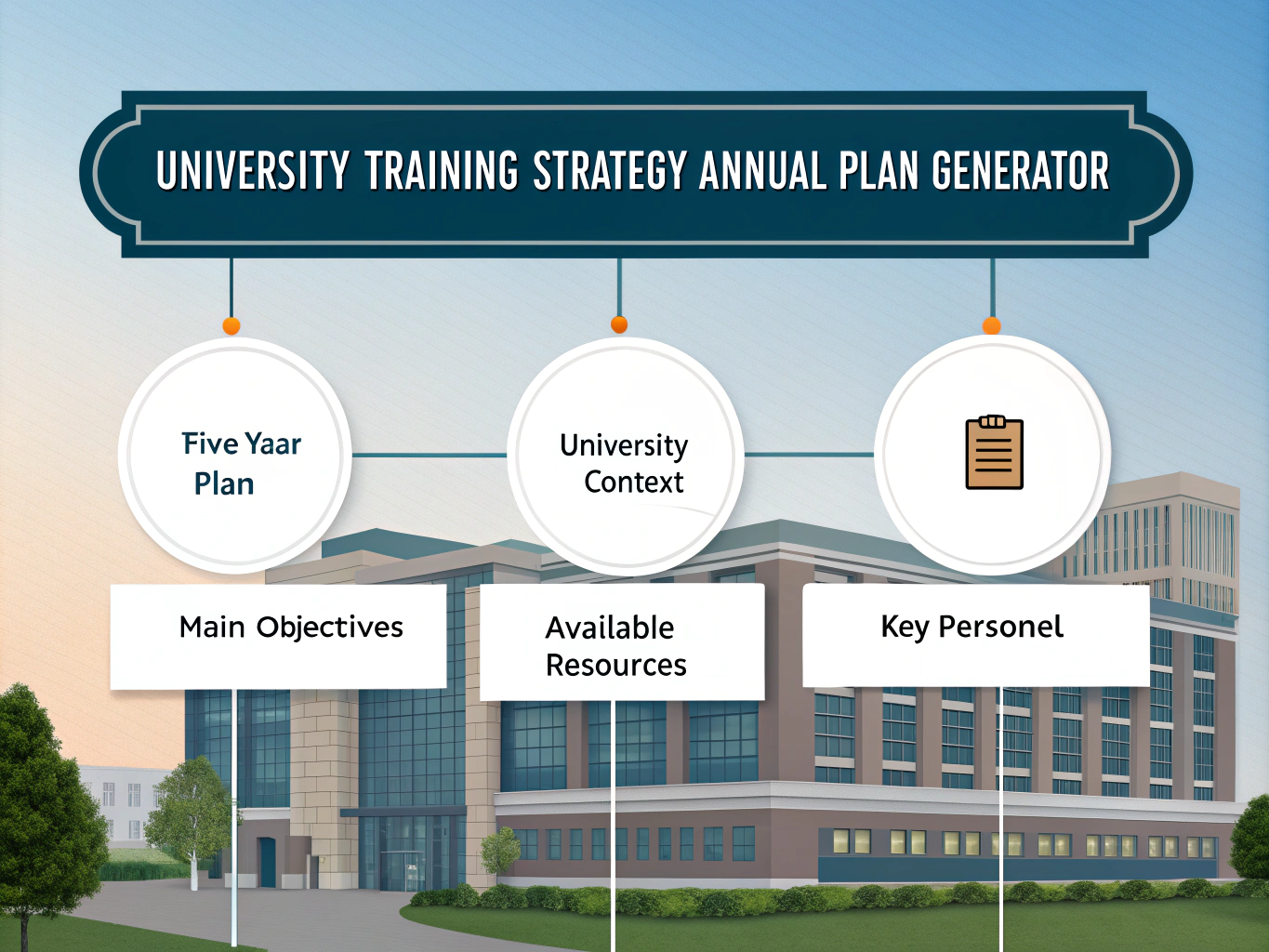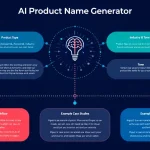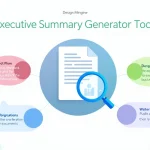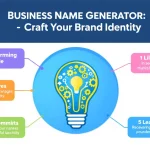Annual Plan Generator for Training Strategy
Is this tool helpful?
How to Use the Annual Plan Generator for University Training Strategy
This Annual Plan Generator helps you create a clear, actionable training strategy tailored to your university’s needs. Follow these steps to fill out the form effectively:
-
Five-Year Plan Overview: Briefly summarize your long-term training strategy. Example inputs:
- “Expand interdisciplinary faculty workshops and integrate AI tools in curriculum development.”
- “Develop sustainable campus training programs focusing on leadership and digital skills.”
-
University Context: Describe the environment and unique challenges of your institution. Examples:
- “A mid-size technical university with 8,000 students aiming to enhance industry partnerships and practical training.”
- “A community college serving a diverse student body, focusing on career readiness and vocational programs.”
-
Main Objectives (3-5): List measurable goals for the upcoming year. Examples:
- “Launch a digital literacy program for faculty by Q3.”
- “Increase participation in cross-departmental training by 30%.”
- “Implement bi-annual feedback surveys to assess training impact.”
-
Available Resources (Optional): Outline your human, financial, and technical assets. For instance:
- “Access to a dedicated training budget of $500,000 and two instructional designers.”
- “Partnership with local tech firms and access to cloud-based learning platforms.”
-
Key Personnel (Optional): Identify individuals responsible for plan execution. Examples:
- “Dr. Alan Smith (Training Coordinator), Ms. Lisa Gomez (IT Support Specialist)”
- “Prof. Rita Johnson (Dean of Faculty Development), Mr. Daniel Kim (Budget Analyst)”
After completing the fields, click “Generate Annual Plan.” The tool will produce a customized training strategy that fits your university’s context and goals.
Introduction to the Annual Plan Generator for University Training Strategy
The Annual Plan Generator is a straightforward, powerful tool designed to help university administrators transform their long-term visions into clear, manageable annual training plans. It connects your university’s five-year strategy with detailed yearly actions, ensuring consistency and focus.
Purpose and Benefits
This tool streamlines annual training plan creation, offering benefits such as:
- Saving time by automating the plan drafting process
- Aligning yearly objectives with your university’s strategic goals
- Providing a structured framework for tracking progress and success
- Facilitating clear resource allocation and role assignments
- Supporting continuous evaluation and plan adjustment
Practical Usage of the Annual Plan Generator
Using this tool, you can develop a comprehensive annual training plan that integrates key strategic elements tailored to your institution.
Key Features and Applications
- Strategic Alignment: The tool ensures your annual training objectives directly support your long-term university goals. For example, if your five-year plan focuses on increasing research capabilities, your annual plan might include objectives such as implementing grant writing workshops or expanding research mentoring programs.
- SMART Objective Development: It guides you in setting Specific, Measurable, Achievable, Relevant, and Time-bound goals. For example, instead of “Improve faculty skills,” use “Train 80% of faculty in new teaching technologies by year-end.”
- Resource Planning: You can factor available financial, human, and technological resources to create feasible action steps. For instance, assigning a budget to purchase new e-learning tools or designating training coordinators.
- Role Clarification: Identify key personnel responsible for each part of the plan, ensuring accountability. Example: “Professor Jane Doe will oversee workshop development; IT staff will support technical training delivery.”
- Monitoring and Evaluation Framework: The generated plan can include timelines and key performance indicators (KPIs) for ongoing assessment, such as quarterly reviews of training attendance or post-training feedback scores.
Example Use Case: Faculty Development Initiative
Consider a university aiming to improve teaching quality and research output:
- Five-Year Plan Overview: “Achieve national recognition for teaching excellence and research innovation.”
- Annual Objectives:
- Establish monthly pedagogical workshops focusing on active learning.
- Introduce peer mentoring for new faculty within the first semester.
- Increase faculty publications by 15% in targeted journals.
- Available Resources: $600,000 training budget, partnership with teaching experts, dedicated staff team of four.
- Key Personnel: “Dr. John Lee (Training Director), Ms. Megan Smith (Workshop Coordinator).”
The generated annual plan would clearly outline action steps, resource assignments, and metrics to track progress, helping the university execute the strategy efficiently.
Example Use Case: Enhancing Online Learning Capabilities
A small university might use the tool to expand digital education:
- Five-Year Plan Overview: “Transform into a leader in distance education by integrating hybrid learning models.”
- Annual Objectives:
- Deploy a scalable Learning Management System (LMS) with integrated student tracking.
- Train 90% of instructors in online pedagogy and digital engagement.
- Increase online course offerings by 25%.
- Available Resources: Limited budget, existing IT infrastructure, support from a contracted LMS provider.
- Key Personnel: “Ms. Rachel Green (E-Learning Specialist), Mr. Tom Harris (IT Manager).”
This plan will provide specific steps to meet research and teaching goals, with clear timelines and evaluation points for ongoing improvement.
Important Disclaimer
The calculations, results, and content provided by our tools are not guaranteed to be accurate, complete, or reliable. Users are responsible for verifying and interpreting the results. Our content and tools may contain errors, biases, or inconsistencies. Do not enter personal data, sensitive information, or personally identifiable information in our web forms or tools. Such data entry violates our terms of service and may result in unauthorized disclosure to third parties. We reserve the right to save inputs and outputs from our tools for the purposes of error debugging, bias identification, and performance improvement. External companies providing AI models used in our tools may also save and process data in accordance with their own policies. By using our tools, you consent to this data collection and processing. We reserve the right to limit the usage of our tools based on current usability factors.







